Antioxidant Activities and Total Phenolic Content of Malaysian Herbs as Components of Active Packaging Film in Beef Patties
Abstract
:1. Introduction
2. Materials and Methods
2.1. Plant Material and Chemicals
2.2. Preparation of Leaf Extract
2.3. Determination of Phytochemical Content
2.4. Determination of Free Radical Scavenging
2.4.1. DPPH Assay
2.4.2. ORAC Assay
2.4.3. TEAC Assay
2.5. Preparation of Active Packaging
2.6. Scanning Electron Microscopy (SEM)
2.7. Preparation of Meat Patties
2.8. Thiobarbituric Acid Reactive Substance (TBARS) Assay
2.9. Percentage of Metmyoglobin
2.10. pH Measurement
2.11. Statistical Analysis
3. Results and Discussion
3.1. Total Phenolic Content and Antioxidant Activity of Different Edible Plants
3.2. Film Morphology
3.3. TBARS Analysis of Stored Meat Patties
3.4. Percentage of Metmyoglobin
3.5. pH Measurement in Meat Patties
4. Conclusions
Author Contributions
Funding
Acknowledgments
Conflicts of Interest
Abbreviations
| SRC | Semi-refined carrageenan |
| DPPH | 2,2-diphenyl-1-picrylhydrazyl |
| TEAC | Trolox equivalent antioxidant capacity |
| ORAC | oxygen radical absorbance capacity |
| PUFAs | polyunsaturated fatty acids |
| BHA | butylated hydroxyanisole |
| BHT | butylated hydroxytoluene |
| G | glycerol |
| CC | Cosmos caudatus |
| PS | Piper sarmentosum |
| PM | Persicaria minor |
| CA | Centella asiatica |
| SP | Syzygium polyanthum |
| TPC | total phenolic content |
| AUC | fluorescein decay curve |
| ABTS•− | 2,2’-azinobis (3-ethylbenzothiazoline- 6-sulfonic acid)-radicals’ cation |
| TBARS | thiobarbituric reactive substance |
| EDTA | ethylenediaminetetraacetic acid |
| MDA | malondialdehyde |
| GAE | gallic acid equivalent |
| TE | Trolox equivalent |
| FRAP | fluorescence recovery after photobleaching |
| APPH | α,α′-Azodiisobutyramidine dihydrochloride |
| PBS | Phosphate-buffered saline |
References
- Ganiari, S.; Choulitoudi, E.; Oreopoulou, V. Edible and active films and coatings as carriers of natural antioxidants for lipid food. Trends Food Sci. Technol. 2017, 68, 70–82. [Google Scholar] [CrossRef]
- Guillen, M.D.; Goicoechea, E. Formation of oxygenated α, β-unsaturated aldehydes and other toxic compounds in sunflower oil oxidation at room temperature in closed receptacles. Food Chem. 2008, 111, 157–164. [Google Scholar] [CrossRef]
- Lopez-de-Dicastillo, C.; Alonso, J.M.; Catala, R.; Gavara, R.; Hernandez-Munoz, P. Improving the antioxidant protection of packaged food by incorporating natural flavonoids into ethylene-vinyl alcohol copolymer (EVOH) films. J. Agric. Food Chem. 2010, 58, 10958–10964. [Google Scholar] [CrossRef] [PubMed]
- Serrano-Leon, J.S.; Bergamaschi, K.B.; Yoshida, C.M.P.; Saldana, E.; Selani, M.M.; Rios-Mera, J.D.; Alencar, S.M.; Contreras-Castillo, C.J. Chitosan active films containing agro-industrial residue extracts for shelf life extension of chicken restructured product. Food Res. Int. 2018, 108, 93–100. [Google Scholar] [CrossRef] [PubMed]
- Trifkovic, K.T.; Milasinovic, N.Z.; Djordjevic, V.B.; Krusic, M.T.; Knezevic-Jugovic, Z.D.; Nedovic, V.A.; Bugarski, B.M. Chitosan microbeads for encapsulation of thyme (Thymus serpyllum L.) polyphenols. Carbohydr. Polym. 2014, 111, 901–907. [Google Scholar] [CrossRef] [PubMed]
- Suppakul, P.; Miltz, J.; Sonneveld, K.; Bigger, S.W. Active packaging technologies with an emphasis on antimicrobial packaging and its applications. Concise Rev. Hypotheses Food Sci. 2003, 68, 408–420. [Google Scholar] [CrossRef]
- Mayachiew, P.; Devahastin, S.; Mackey, B.M.; Niranjan, K. Effects of drying methods and conditions on antimicrobial activity of edible chitosan films enriched with galangal extract. Food Res. Intern. 2010, 43, 125–132. [Google Scholar] [CrossRef]
- Dos Santos Caetano, K.; Almeida Lopes, N.; Haas Costa, T.M.; Brandelli, A.; Rodrigues, E.; Hickmann Flôres, S.; Cladera-Olivera, F. Characterization of active biodegradable films based on cassava starch and natural compounds. Food Packaging Shelf Life 2018, 16, 138–147. [Google Scholar] [CrossRef]
- Joanne Kam, W.-Y.; Mirhosseini, H.; Abas, F.; Hussain, N.; Hedayatnia, S.; Florence Chong, H.-L. Antioxidant activity enhancement of biodegradable film as active packaging utilizing crude extract from durian leaf waste. Food Control 2018, 90, 66–72. [Google Scholar] [CrossRef]
- Breda, C.A.; Morgado, D.L.; Assis, O.B.G.; Duarte, M.C.T. Processing and characterization of chitosan films with incorporation of ethanolic extract from “pequi” peels. Macromol. Res. 2017, 25, 1049–1056. [Google Scholar] [CrossRef]
- Siripatrawan, U.; Noipha, S. Active film from chitosan incorporating green tea extract for shelf life extension of pork sausages. Food Hydrocoll. 2012, 27, 102–108. [Google Scholar] [CrossRef]
- Toohey, E.S.; Kerr, M.J.; van de Ven, R.; Hopkins, D.L. The effect of a kiwi fruit based solution on meat traits in beef m. semimembranosus (topside). Meat Sci. 2011, 88, 468–471. [Google Scholar] [CrossRef] [PubMed]
- Pereira de Abreu, D.A.; Paseiro Losada, P.; Maroto, J.; Cruz, J.M. Natural antioxidant active packaging film and its effect on lipid damage in frozen blue shark (Prionace glauca). Innov. Food Sci. Emerg. Technol. 2011, 12, 50–55. [Google Scholar] [CrossRef]
- Seydim, A.C.; Sarikus, G. Antimicrobial activity of whey protein based edible films incorporated with oregano, rosemary and garlic essential oils. Food Res. Int. 2006, 39, 639–644. [Google Scholar] [CrossRef]
- Vimala, S.; Ilham, M.A.; Rashih, A.A.; Rohana, S.; Juliza, M. Antioxidant and skin whitening standardized extracts: Cosmeceutical and neutraceutical products development and commercialization in FRIM, in Sustainable Management and Utilization of Medicinal Plant Resources. In Sustainable Management and Utilization of Medicinal Plant Resources: Proceedings of the International Conference on Medicinal Plants; Universiti Putra Malaysia: Kuala Lumpur, Malaysia, 2006; p. 281. [Google Scholar]
- Cheng, S.H.; Barakatun-Nisak, M.Y.; Anthony, J.; Ismail, A. Potential medicinal benefits of Cosmos caudatus (Ulam Raja): A scoping review. J. Res. Med. Sci. 2015, 20, 1000–1006. [Google Scholar] [PubMed]
- Seyedreihani, S.F.; Tan, T.-C.; Alkarkhi, A.F.M.; Easa, A.M. Total phenolic content and antioxidant activity of Ulam raja (Cosmos caudatus) and quantification of its selected marker compounds: Effect of extraction. Int. J. Food Prop. 2016, 20, 260–270. [Google Scholar] [CrossRef]
- Zaidan, M.R.S.; Noor Rain, A.; Badrul, A.R.; Adlin, A.; Norazah, A.; Zakiah, I. In vitro screening of five local medicinal plants for antibacterial activity using disc diffusion method. Trop. Biomed. 2005, 22, 165–170. [Google Scholar]
- Ridtitid, W.; Peerati, R.; Wantana, R.; Wongnawa, M. Studies of the anti-inflammatory and antipyretic activities of the methanolicextract of Piper sarmentosum Roxb. Leaves in rats. Songklanakarin J. Sci. Technol. 2007, 29, 1519–1526. [Google Scholar]
- Sireeratawong, S.; Vannasiri, S.; Sritiwong, S.; Itharat, A.; Jaijoy, K. Anti-inflammatory, anti-nociceptive and antipyretic effects of the ethanol extract from root of Piper sarmentosum Roxb. J. Med. Assoc. Thai. 2010, 93, S1–S6. [Google Scholar]
- Zakaria, Z.A.; Patahuddin, H.; Mohamad, A.S.; Israf, D.A.; Sulaiman, M.R. In vivo anti-nociceptive and anti-inflammatory activities of the aqueous extract of the leaves of Piper sarmentosum. J. Ethnopharmacol. 2010, 128, 42–48. [Google Scholar] [CrossRef]
- Chanwitheesuk, A.; Teerawutgulrag, A.; Rakariyatham, N. Screening of antioxidant activity and antioxidant compounds of some edible plants of Thailand. Food Chem. 2005, 92, 491–497. [Google Scholar] [CrossRef]
- Ugusman, A.; Zakaria, Z.; Hui, C.K.; Nordin, N.A.M.M. Piper sarmentosum inhibits ICAM-1 and Nox4 gene expression in oxidative stress-induced human umbilical vein endothelial cells. BMC Complement. Altern. Med. 2011. [Google Scholar] [CrossRef] [PubMed]
- Syed Ab Rahman, S.F.; Sijam, K.; Omar, D. Chemical composition of piper sarmentosum extracts and antibacterial activity against plant pathogenic bacteria pseudomonas fuscovaginae and Xanthomonas oryzae pv. oryzae. J. Plant Dis. Protect. 2014, 121, 237–242. [Google Scholar] [CrossRef]
- Nanasombat, S.; Teckchuen, N. Antimicrobial, antioxidant and anticancer activities of Thai local vegetables. J. Med. Plant Res. 2009, 3, 444–449. [Google Scholar]
- Siro, I.; Fenyvesi, E.; Szente, L.; de Meulenaer, B.; Devlieghere, F.; Orgovanyi, J.; Senyi, J.; Barta, J. Release of alpha-tocopherol from antioxidative low-density polyethylene film into fatty food simulant: Influence of complexation in beta-cyclodextrin. Food Addit. Contam. 2006, 23, 845–853. [Google Scholar] [CrossRef]
- Vimala, S.; Rohana, S.; Rashih, A.; Juliza, M. Antioxidant evaluation in Malaysian medicinal plant: Persicaria minor (Huds.) leaf. Sci. J. Med. Clin. Tr. 2012. [Google Scholar]
- Pizzorno, J.E.; Murray, M.T. Textbook of Natural Medicine, 4th ed.; Edinburgh Churchill Livingstone: New York, NY, USA, 2013. [Google Scholar]
- Hidayati, M.D.; Ersam, T.; Shimizu, K.; Fatmawati, S. Antioxidant activity of Syzygium polyanthum extracts. Indones. J. Chem. 2017, 17, 49–53. [Google Scholar] [CrossRef]
- Nurul, M.A.A.; Shafik, H.; Maria, A.P.; Maria, G.G. Solvent effect on antioxidant activity and total phenolic content of Betula alba and Convolvulus arvensis. Int. J. Biol. Biomol. Agric. Food Biotechnol. Eng. 2013, 7, 152–157. [Google Scholar]
- Farhan, A.; Hani, N.M. Characterization of edible packaging films based on semi-refined kappa-carrageenan plasticized with glycerol and sorbitol. Food Hydrocoll. 2017, 64, 48–58. [Google Scholar] [CrossRef]
- Ili Balqis, A.M.; Nor Khaizura, M.A.R.; Russly, A.R.; Nur Hanani, Z.A. Effects of plasticizers on the physicochemical properties of kappa-carrageenan films extracted from Eucheuma cottonii. Int. J. Biol. Macromol. 2017, 103, 721–732. [Google Scholar] [CrossRef]
- Chandrasekar, V.; Belur, P.D.; Regupathi, I. Effect of hydroxybenzoic acids antioxidants on the oxidative stability of sardine oil. Resour. Efficient Technol. 2016, 2, S114–S118. [Google Scholar] [CrossRef]
- Xu, Z.; Tang, M.; Li, Y.; Liu, F.; Li, X.; Dai, R. Antioxidant properties of Du-zhong (Eucommia ulmoides Oliv.) extracts and their effects on color stability and lipid oxidation of raw pork patties. J. Agric. Food Chem. 2010, 58, 7289–7296. [Google Scholar] [CrossRef] [PubMed]
- Hashim, P.; Sidek, H.; Helan, M.H.; Sabery, A.; Palanisamy, U.D.; Ilham, M. Triterpene composition and bioactivities of Centella asiatica. Molecules 2011, 16, 1310–1322. [Google Scholar] [CrossRef] [PubMed]
- Reihani, S.; Easa, S.F.A. Antioxidant activity and total phenolic content in aqueous extracts of selected traditional Malay salads (Ulam). Int. Food Res. J. 2012, 19, 1439–1444. [Google Scholar]
- Mello, B.C.B.S.; Hubinger, M.D. Antioxidant activity and polyphenol contents in Brazilian green propolis extracts prepared with the use of ethanol and water as solvents in different pH values. Int. J. Food Sci. Technol. 2012, 47, 2510–2518. [Google Scholar] [CrossRef]
- Miguel, M.G.; Nunes, S.; Dandlen, S.A.; Cavaco, A.M.; Antunes, M.D. Phenols and antioxidant activity of hydro-alcoholic extracts of propolis from Algarve, South of Portugal. Food Chem. Toxicol. 2010, 48, 3418–3423. [Google Scholar] [CrossRef] [PubMed]
- Thaipong, K.; Boonprakob, U.; Crosby, K.; Cisneros-Zevallos, L.; Hawkins Byrne, D. Comparison of ABTS, DPPH, FRAP, and ORAC assays for estimating antioxidant activity from guava fruit extracts. J. Food Compos. Anal. 2006, 19, 669–675. [Google Scholar] [CrossRef]
- Gil, M.; Tomás-Barberán, F.; Hess-Pierce, B.; Kader, A. Antioxidant capacities, phenolic compounds, carotenoids, and vitamin C contents of nectarine, peach, and plum cultivars from California. J. Agric. Food Chem. 2002, 50, 4976–4982. [Google Scholar] [CrossRef] [PubMed]
- Priyadarshi, R.; Kumar, B.; Negi, Y.S. Chitosan film incorporated with citric acid and glycerol as an active packaging material for extension of green chilli shelf life. Carbohydr. Polym. 2018, 195, 329–338. [Google Scholar] [CrossRef] [PubMed]
- Jayasena, D.D.; Ahn, D.U.; Nam, K.C.; Jo, C. Factors affecting cooked chicken meat flavour: A review. World’s Poult. Sci. J. 2013, 69, 515–526. [Google Scholar] [CrossRef]
- Mohd Azman, N.A.; Gallego, M.G.; Segovia, F.; Abdullah, S.; Shaarani, S.M.; Almajano Pablos, M.P. Study of the properties of bearberry leaf extract as a natural antioxidant in model foods. Antioxidants 2016, 5, 11. [Google Scholar] [CrossRef] [PubMed]
- Hamid, K.H.A.; Azman, N.; Sharaani, S.; Zain, N.; Ahmad, N.; Sulaiman, A.Z.; Chik, S.S.T.; Ishak, W.F.W.; Pablos, M.P.A. Alchemilla vulgaris and Filipendula ulmaria extracts as potential natural preservatives in beef patties. Malays. J. Anal. Sci. 2017, 21, 986–995. [Google Scholar]
- Gomez, F.S.; Sanchez, S.P.; Iradi, M.G.; Azman, N.A.; Almajano, M.P. Avocado seeds: Extraction optimization and possible use as antioxidant in food. Antioxidants 2014, 3, 439–454. [Google Scholar] [CrossRef] [PubMed]
- Azman, N.A.M.; Gallego, M.G.; Julia, L.; Fajari, L.; Almajano, M. The effect of Convolvulus arvensis dried extract as a potential antioxidant in food models. Antioxidants 2015, 4, 170–184. [Google Scholar] [CrossRef] [PubMed]
- Skowyra, M.; Falguera, V.; Gallego, G.; Peiro, S.; Almajano, M.P. Antioxidant properties of aqueous and ethanolic extracts of tara (Caesalpinia spinosa) pods in vitro and in model food emulsions. J. Sci. Food Agric. 2014, 9, 911–918. [Google Scholar] [CrossRef] [PubMed]
- Camo, J.; Beltran, J.A.; Roncales, P. Extension of the display life of lamb with an antioxidant active packaging. Meat Sci. 2008, 80, 1086–1091. [Google Scholar] [CrossRef]
- Contini, C.; Alvarez, R.; O’Sullivan, M.; Dowling, D.P.; Gargan, S.O.; Monahan, F.J. Effect of an active packaging with citrus extract on lipid oxidation and sensory quality of cooked turkey meat. Meat Sci. 2014, 96, 1171–1176. [Google Scholar] [CrossRef] [PubMed]
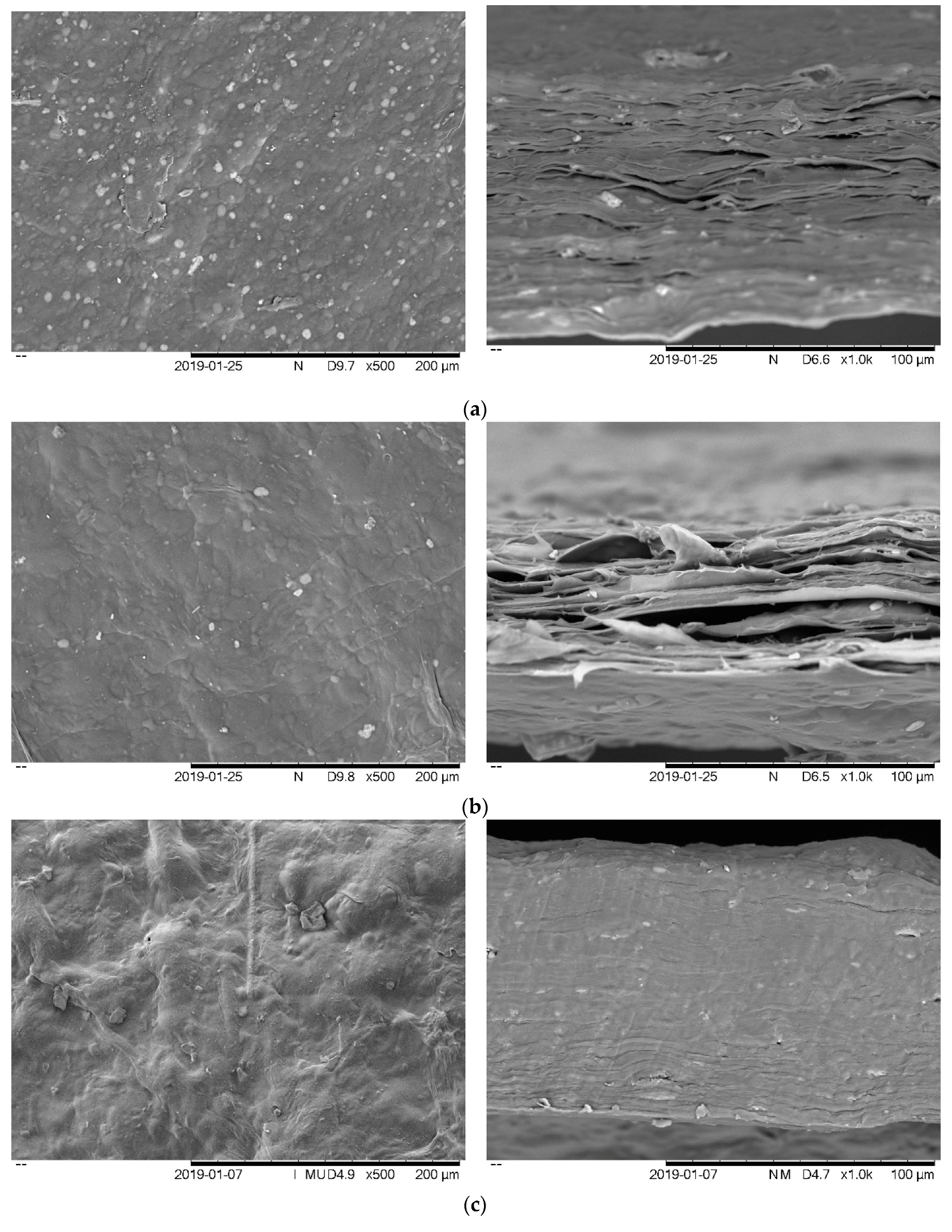
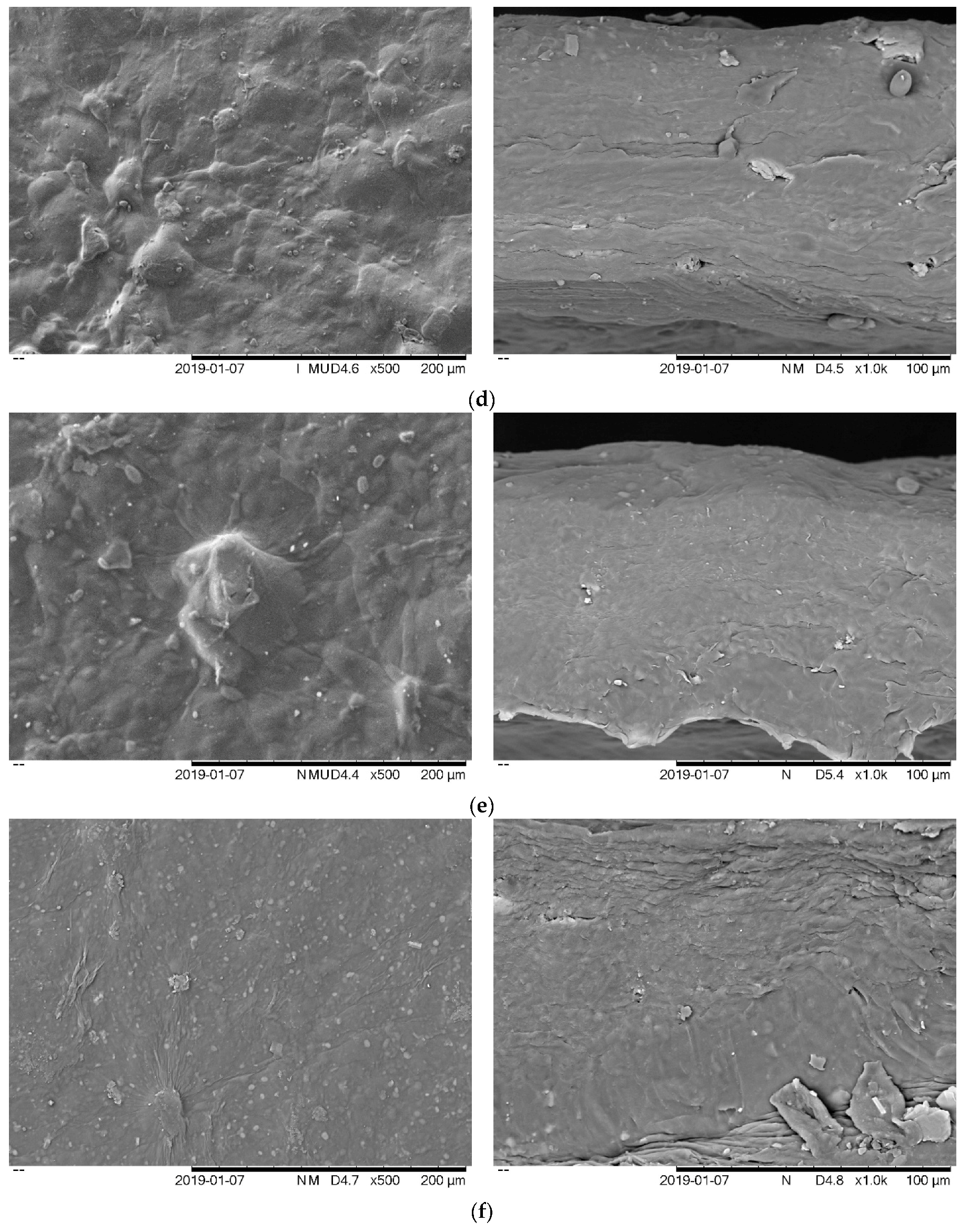
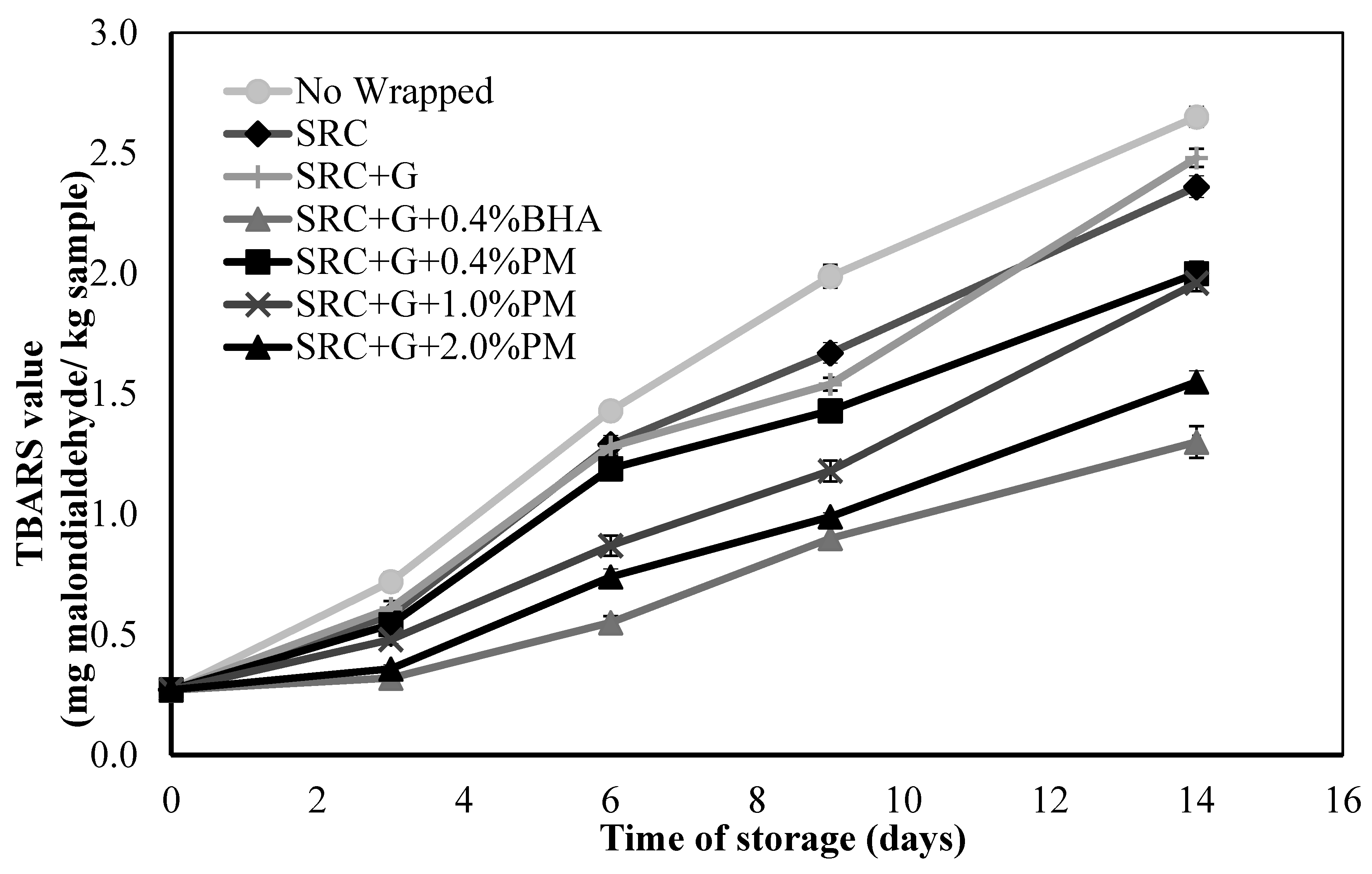
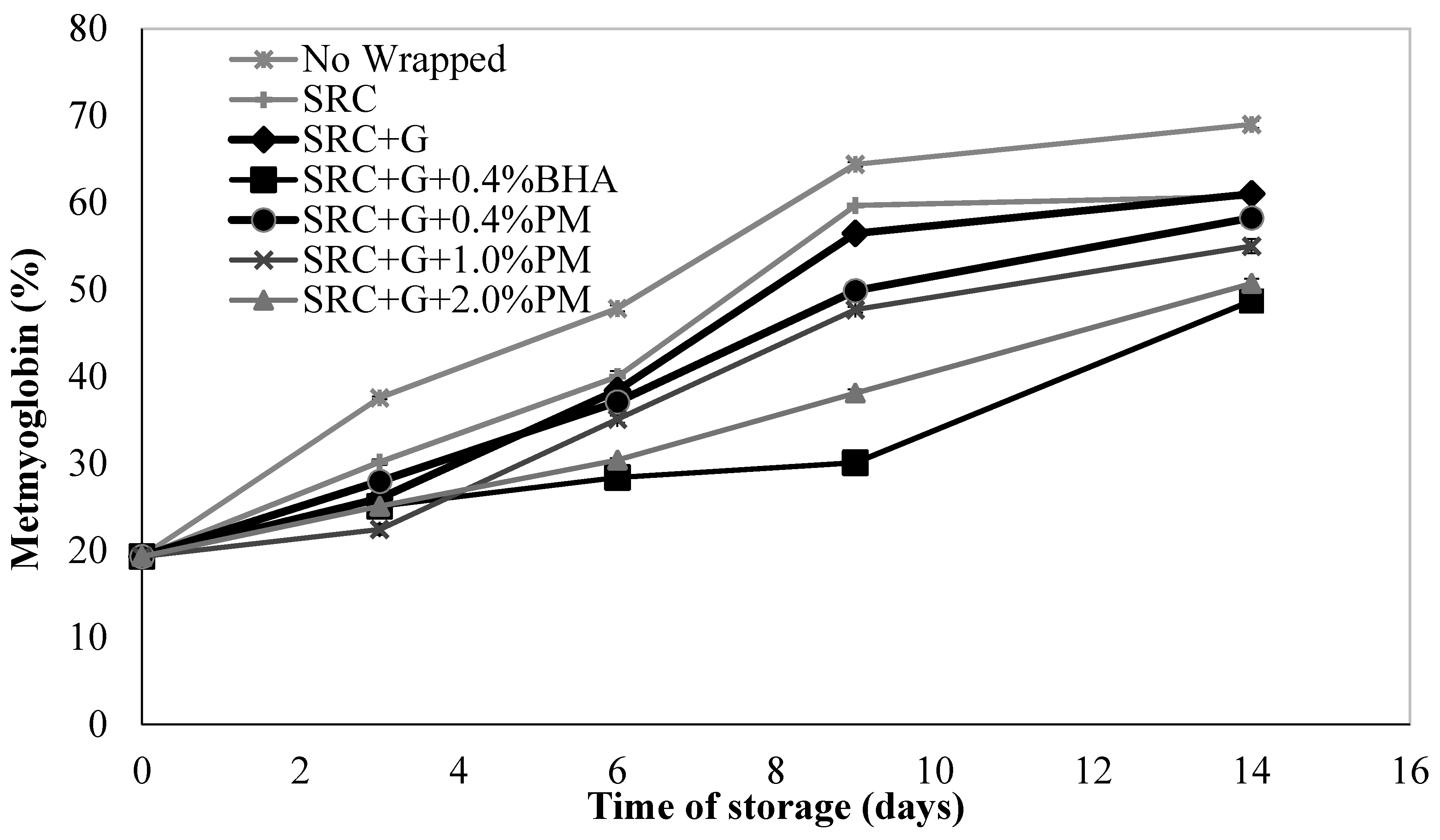
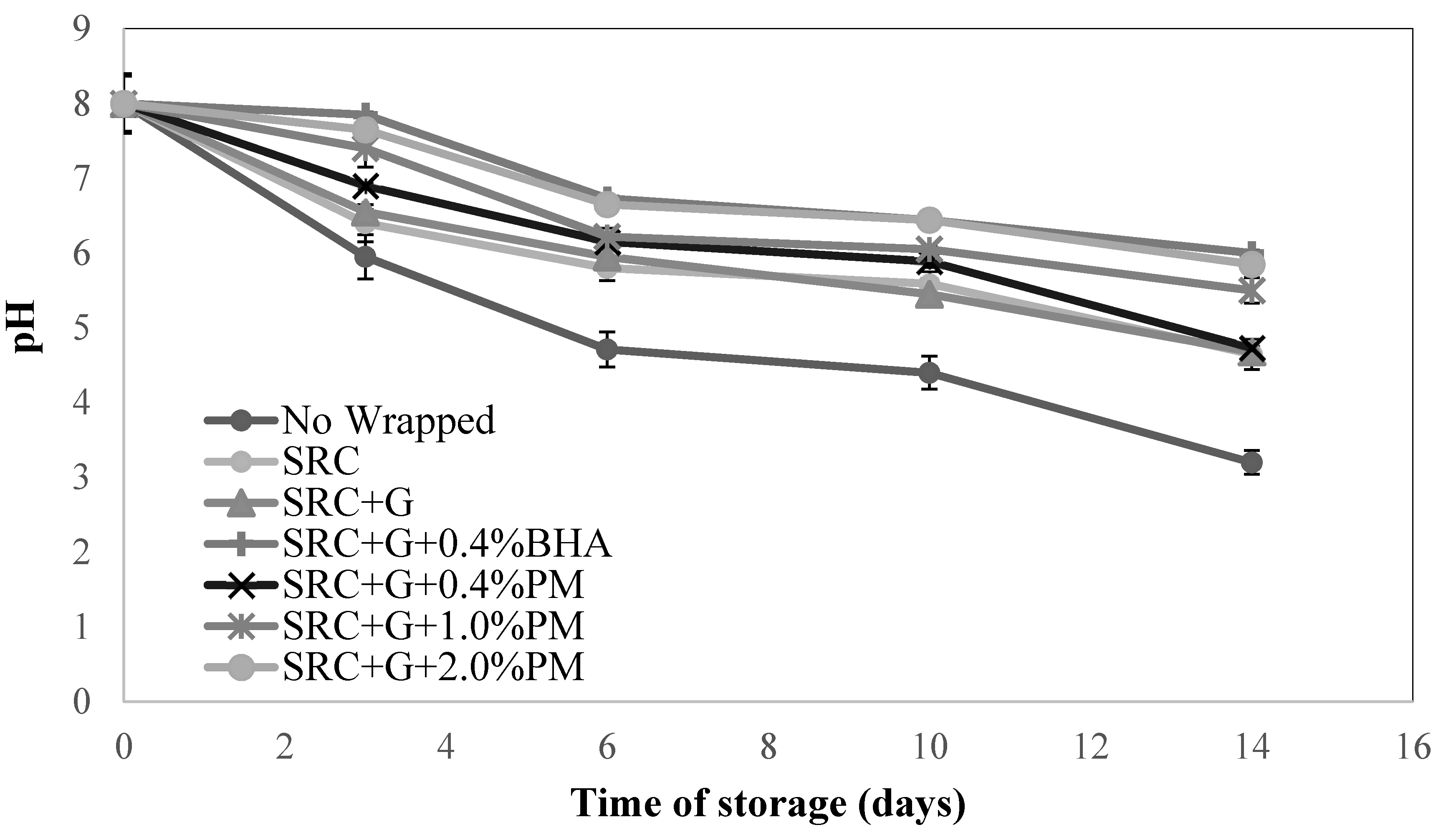
| Assays | PM | CC | PS | CA | SP |
|---|---|---|---|---|---|
| TPC (mg GAE/L sample) | 1.63 ± 0.02 a | 1.62 ± 0.02 a | 1.47 ± 0.01 b | 1.29 ± 0.01 c | 1.37 ± 0.02 d |
| DPPH (mg TE/L sample) | 719.89 ± 0.73 a | 680.27 ± 0.76 b | 576.24 ± 0.82 c | 600.09 ± 0.89 d | 478.34 ± 0.83 e |
| ORAC (mg TE/L sample) | 5.81 ± 0.05 a | 4.09 ± 0.03 b | 2.98 ± 0.12 c | 2.65 ± 0.08 d | 1.99 ± 0.05 e |
| TEAC (mg TE/L sample) | 27.16 ± 0.82 a | 11.90 ± 0.57 b | 16.75 ± 0.89 c | 27.59 ± 0.86 a | 9.87 ± 0.50 d |
© 2019 by the authors. Licensee MDPI, Basel, Switzerland. This article is an open access article distributed under the terms and conditions of the Creative Commons Attribution (CC BY) license (http://creativecommons.org/licenses/by/4.0/).
Share and Cite
Wan Yahaya, W.A.; Abu Yazid, N.; Mohd Azman, N.A.; Almajano, M.P. Antioxidant Activities and Total Phenolic Content of Malaysian Herbs as Components of Active Packaging Film in Beef Patties. Antioxidants 2019, 8, 204. https://doi.org/10.3390/antiox8070204
Wan Yahaya WA, Abu Yazid N, Mohd Azman NA, Almajano MP. Antioxidant Activities and Total Phenolic Content of Malaysian Herbs as Components of Active Packaging Film in Beef Patties. Antioxidants. 2019; 8(7):204. https://doi.org/10.3390/antiox8070204
Chicago/Turabian StyleWan Yahaya, Wan Amnin, Noraziah Abu Yazid, Nurul Aini Mohd Azman, and María Pilar Almajano. 2019. "Antioxidant Activities and Total Phenolic Content of Malaysian Herbs as Components of Active Packaging Film in Beef Patties" Antioxidants 8, no. 7: 204. https://doi.org/10.3390/antiox8070204
APA StyleWan Yahaya, W. A., Abu Yazid, N., Mohd Azman, N. A., & Almajano, M. P. (2019). Antioxidant Activities and Total Phenolic Content of Malaysian Herbs as Components of Active Packaging Film in Beef Patties. Antioxidants, 8(7), 204. https://doi.org/10.3390/antiox8070204






